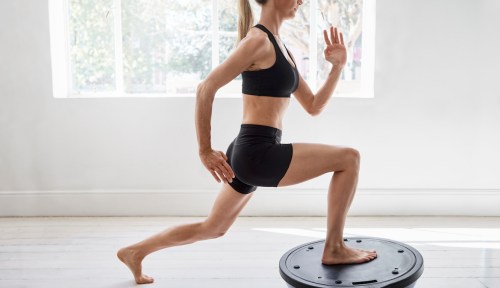Looking To Strengthen Your Pelvic Floor? Here’s a Secret Weapon
Learn how to engage all of your small stabilizer muscles by hopping on an unstable surface, using balance boards for pelvic floor strength.

Although working on your pelvic floor is all the rage, sometimes actually figuring out how to do that can prove challenging. Should you be relaxing it or strengthening it? How do you find and activate your pelvic floor muscles? How do you even know if your pandemic floor needs a little TLC?
Experts in This Article
For those uninitiated, the pelvic floor is the sling of muscles at the base of your pelvis that keep your organs in place. Being able to relax your pelvic floor is key to being able to go to the bathroom, while having a resilient pelvic floor is important to prevent incontinence. But beyond those essential functions, your pelvic floor also plays a big role in your posture and stability.
“The pelvic floor is literally the base of our core,” physical therapist Kelly Sadauckas, DPT, OCS, founder of Pelvic Floored, previously told Well+Good. The pelvic floor stabilizes the pelvis, which in turn stabilizes and aligns the hips and spine. If something is off with the pelvic floor, something could be off throughout your whole body. “From walking up the stairs, to weightlifting, to attempting to jump or move heavy boxes, if the pelvic floor isn’t functioning well, you will see compensatory patterns of leaning to one side, or having an uneven stride length when running, or observing uneven wear patterns on your shoes or socks.”
Unfortunately, stress and being stationary for long periods of time can impact pelvic floor health, and experts have seen an uptick in pelvic floor–related issues in recent years. Relieving stress, deep breathing, optimizing your work set-up are all key to pelvic floor health. But beyond doing kegels, you can actually work on your pelvic floor—and all the muscles that provide it with support—with an unexpected tool: balance boards.
Whether on a Bosu ball or a platform on a cylinder or springs, balance boards, well, challenge your balance. They recruit the small stabilizing muscles, such as the erector spinae (which surround your spine) and other deep core muscles—like those in the pelvic floor—to keep you upright even when the ground beneath you is unsteady. So using a balance board works both your pelvic floor, and the entire core system of which it is a part.
“When you’re on the board, because you are centered on this fulcrum of springs, your body is forced to stay centered,” says personal trainer Mike Curry, the creator of the StrongBoard, a balance board made up of two boards with four springs sandwiched in between. “So we’re working those deeper, intricate stabilizing muscles that often get ignored with your traditional exercises where we isolate certain muscle groups.”
Working on your stabilizer muscles sounds like an abstract concept, but the moment you step on the board, you get what Curry is talking about. You feel your whole body snap to attention in a way that it doesn’t when you’re not trying to prevent yourself from wobbling, which results in a constant challenge.
“The brain and the muscles are trying to figure out why they can’t stabilize,” Curry says. “Your brain is constantly sending messages to your muscles to engage when you’re walking or when you’re doing anything. When it gets on here, it starts sending those messages, but they’re not working, so it’s rapidly trying to figure out why. But the more it does that, the more it starts recruiting more muscles.”
All balance boards will have this effect, but Curry says the springs on the StrongBoard make it a bigger challenge, since springs are always trying to get back to their upright position, and the weight you’re baring on top of the board is fighting with that.

StrongBoard Balance Board — $269.00
The StrongBoard allows you to test your balance and build your strength. Just standing on the board, you feel your muscles engage as they try to stabilize you. But you can also perform exercises like squats, lunges, planks, tricep dips, and more on the board to give specific muscle groups an intense workout.
Curry recommends very basic exercises that challenge your balance to strengthen your pelvic floor while using the StrongBoard, since the device will “challenge you to brace your core to get more out of your movements, forcing those deep, intricate stabilizing muscles to stay contracted.” Specifically, the exercises he suggests include:
- 1.Squats with both feet on the board. You can slowly move up and down in the squat, or test your strength and balance in an extended squat hold.
- 2.Hip thrusts with your feet on the board and your shoulders on the ground.
- 3.A plank with your arms on the board and your feet on the ground. Try mixing it up with some slow mountain climbers.
- 4.Lunges with your front foot on the board and your back foot on the ground.
Even though these exercises are known to work your hamstrings, quads, glutes, and core, with the added challenge of stabilizing, “your pelvic floor muscles will have no say in relaxing,” says Curry.
Sign up for the Well+Good SHOP Newsletter
Get exclusive deals on wellness, beauty, fitness, and food products that have been hand-picked by our editors.
Got it, you've been added to our email list.









